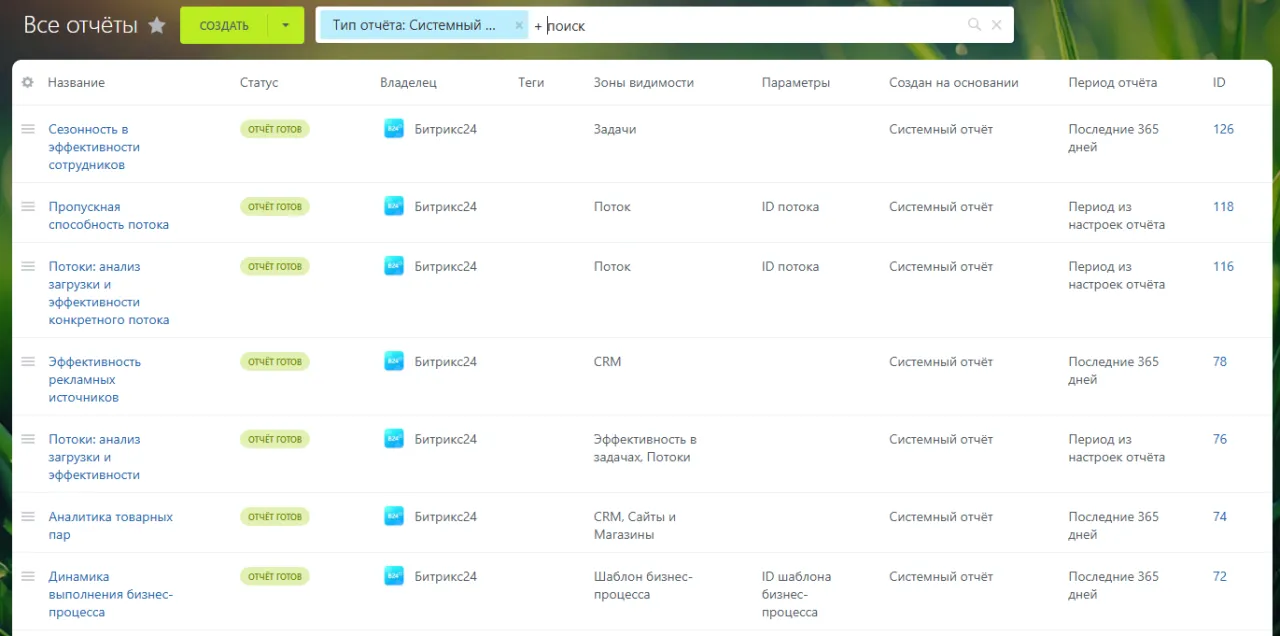Running a business without analytics is like setting out on a free voyage. However, it was impossible to generate analytical reports directly in Bitrix24 for a long time. For analysis, it was necessary (or still is necessary) to upload data and use third-party services – Looker Studio, DataLens, Power BI and others. The tools are powerful and flexible, but uploading/downloading takes time and resources. In addition, medium and large businesses need to pay for pro-tariffs, and access to Looker Studio is currently limited for Russian users.
Another drawback is that by default, only the person who prepared the analytics has access to it. To share the results with the team, you need to send reports by email or messenger. Files and links get lost, deleted, and do not always open correctly – there is no sense of convenience.
The Bitrix24 BI Constructor module built into the corporate system eliminates these limitations. We will tell you what it can do, what tasks it is best suited for, and how to start working with it to improve business performance tomorrow.
BI Constructor: what is it?
BI Constructor is a tool for BI analytics (Business Intelligence). It collects information from all over Bitrix24 into reports and visually presents it on dashboards. They contain graphs, charts and tables.
The designer uses data from the entire corporate system, including CRM, as well as from external sources: imported CVS files, connected advertising accounts and the 1C database. The tool is available in boxed versions and on paid Bitrix24 tariffs, starting with Standard. There is no need to pay for it additionally.
By default, BI Constructor is displayed in the corporate portal menu. If you do not see it, check your tariff or contact your integrator or INTERVOLGA specialists.
BI Constructor Bitrix24 is developed on the Apache Superset platform. The system is quite new, but rapidly developing – this is facilitated by the open source code. It is characterized by high performance, flexibility of queries, the ability to work with big data and high-quality data visualization.
If we compare products on the Apache recent mobile phone number data Superset platform and the popular Looker Studio from Google, the latter loses when creating complex reports using multiple data sources. Bitrix24 BI Constructor easily copes with such tasks, connecting data sets using SQL queries. Another plus is the convenient interface of standard reports, which is understandable even for a beginner.
There are reports in the CRM tab. Why use BI Constructor?
The “Reports” tool in the Bitrix24 CRM section is very outdated. The capabilities of the BI Constructor are much broader, and the data presentation is more visual and convenient.
What is the use of BI Constructor?
10 reasons to start working with Bitrix24 BI Constructor:
- a Russian product that will not have restricted access;
- free for users of B24 commercial tariffs (Standard and higher) – no need to pay anything extra;
- a large number of additional reports gambler data in the Marketplace, available with an active subscription;
- refusal from unnecessary actions – integration with a third-party analytical service and data import;
- one-window principle – all work is within one application;
- a large set of tools – not just reports, but full-fledged dashboards with customizable data visualization;
- high level of detail, flexible and precise report customization;
- quick export of reports to Excel and dashboards to .pdf;
- Collaborative access – create and edit analytics together with managers at different levels and share results with line employees;
- customization of analytics taking into account the specifics of your business;
- new growth points and insights – evaluate results, get inspired and make the right decisions for business development.
Bitrix24 BI Constructor allows you to select full prospect name for the second field analyze key business indicators directly within the system – without uploading data to third-party services and additional payments.
What tasks is the tool not suitable for?
BI Constructor is a powerful and flexible tool for analytics, but it is not artificial intelligence. It does not provide advice, tips, or long-term forecasts based on the collected data. The constructor helps make the right decisions, but it does not generate them itself.
Also, in BI Constructor it is impossible to customize the appearance of diagrams, graphs and tables. It is not possible to design them in accordance with the brand book or the design of the corporate portal.
In addition, it is impossible to set up automation in Bitrix24 based on any data from the designer dashboards.
How to get started with BI Constructor
The “BI Constructor” section is displayed in the Bitrix24 menu on the left. The tool is ready to work right away – go inside and start tracking dozens of metrics for your business.
By default, there are 26 standard (system) reports in the list. Here are some of them:
- ABC analysis of clients
- Lead generation analytics
- Commodity analytics of transactions
- Dynamics of business process execution
- Tasks: loading performers and departments
- Cohort analysis of clients
- Comprehensive transaction analytics
- Key business indicators
- Flow capacity
- Comparative analytics of product sales
- Customer Retention and Churn
- Efficiency of advertising sources

List of system reports in BI Designer
This list is constantly expanding: in a year and a half, the developers have added 21 new standard reports and brought BI Constructor beyond the CRM. Now, with the help of this tool, you can analyze not only sales, but also tasks, business and smart processes, product catalog, and personal performance indicators of each employee.
It is easy to use a ready-made report: open any of the list, and the designer will automatically generate it, “pulling” the necessary data from the corporate system. Before starting work, in “General Settings”, you can set the required analysis period for all reports at once.
Any system report can be copied, renamed and edited – add or remove filters, cards, graphs and tables based on the desired data set. There are many editing options, but you need to understand which data set to use and how, how to set up filtering correctly.
BI Constructor: what data sets can you work with?
Data sets, also known as datasets, also known as entity fields, are all different names for information about company processes, transactions, partners, accounts, and much more. From Bitrix24, you can use more than 40 data sets from these groups:
- transactions;
- leads;
- product catalog;
- projects and tasks;
- business processes;
- smart processes;
- companies and contacts;
- signature and personnel electronic document management;
- cases, stages and connections of cases with CRM;
- accounts and CP;
- users, calls and company structure;
- CoPilot data with scripted conversation scores.
You can add your own datasets from CSV files, 1C and connected advertising accounts: Yandex Direct, VK Advertising and others. In particular, for advertising, it is possible to add advertising sources and advertising expense statistics to reports. To do this, you will need to combine data sets using an SQL query. If you do not know the language of structured queries, write to us, we will help.
5 Essential BI Constructor Reports for Managers
Every business is unique and has its own specifics. But many have common metrics that most managers need to track and analyze.
Here are five standard BI Constructor reports that you should use right now to look at your business from a new angle:
- Transaction analytics. Look at the overall sales picture, identify periods of customer activity and where they most often come to you from. With this data, you can improve planning and adjust your sales strategy.
- Lead generation analytics. Study how successfully the company attracts leads. The dashboard shows how many leads came in different months, from which sources, the number of leads for each manager, the distribution of leads by stages, and other indicators.
- Key business indicators. Look at revenue dynamics, the number of deals in progress and their amount, assess the trend and forecast the amount of profit or loss.
- ABC Customer Analysis: Classify all customers into 3 categories and determine which segment to focus on to increase sales and revenue.
- Comprehensive deal analytics. Differs from the first report by a wider range of data and analysis of conversion and revenue. A convenient tool for identifying sales trends and evaluating team performance.
These reports can be used without laborious setup to view and analyze key business indicators. And line employees can be given access to the reports “My workload and efficiency” and “My personal indicators”. They will help everyone to objectively evaluate their work, pay attention to successes and failures, determine their contribution to the company’s work and their real role in the team.
